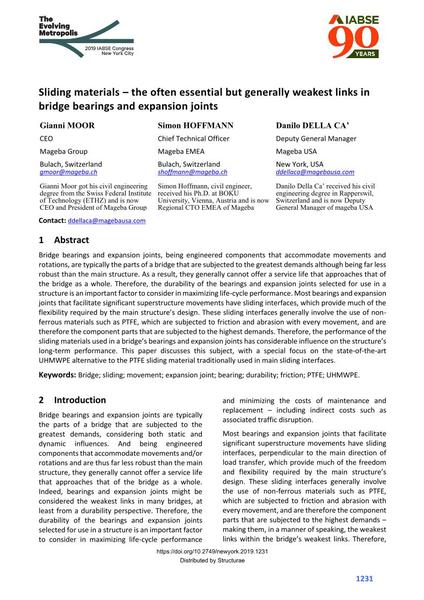Sliding materials – the often essential but generally weakest links in bridge bearings and expansion joints

|
|
|||||||||||
Bibliografische Angaben
| Autor(en): |
Gianni Moor
(Mageba Group)
Simon Hoffmann (Mageba EMEA) Danilo Della Ca' (Mageba USA) |
||||
|---|---|---|---|---|---|
| Medium: | Tagungsbeitrag | ||||
| Sprache(n): | Englisch | ||||
| Tagung: | IABSE Congress: The Evolving Metropolis, New York, NY, USA, 4-6 September 2019 | ||||
| Veröffentlicht in: | The Evolving Metropolis | ||||
|
|||||
| Seite(n): | 1231-1237 | ||||
| Anzahl der Seiten (im PDF): | 7 | ||||
| DOI: | 10.2749/newyork.2019.1231 | ||||
| Abstrakt: |
Bridge bearings and expansion joints, being engineered components that accommodate movements and rotations, are typically the parts of a bridge that are subjected to the greatest demands although being far less robust than the main structure. As a result, they generally cannot offer a service life that approaches that of the bridge as a whole. Therefore, the durability of the bearings and expansion joints selected for use in a structure is an important factor to consider in maximizing life-cycle performance. Most bearings and expansion joints that facilitate significant superstructure movements have sliding interfaces, which provide much of the flexibility required by the main structure’s design. These sliding interfaces generally involve the use of non- ferrous materials such as PTFE, which are subjected to friction and abrasion with every movement, and are therefore the component parts that are subjected to the highest demands. Therefore, the performance of the sliding materials used in a bridge’s bearings and expansion joints has considerable influence on the structure’s long-term performance. This paper discusses this subject, with a special focus on the state-of-the-art UHMWPE alternative to the PTFE sliding material traditionally used in main sliding interfaces. |
||||
| Stichwörter: |
Brücke Dauerhaftigkeit Brückenlager Reibung Fahrbahnübergangskonstruktion (FÜK) Gleiten PTFE UHMWPE
|
||||
